
Albert Menashe sits in one of the four rooms in his Southwest Portland, Ore., home that are filled with audio equipment on March 19, 2025.
Kristian Foden-Vencil / OPB
In Albert Menashe’s home office, there’s a collection of audio machines: a phonograph with a big wooden horn; a record player with a stack of 45s, and a jukebox from 1958.
“This is my favorite,” said the retired Portland financier on a recent Wednesday morning. “Because I’ve got really good stuff in there: Dion and the Belmonts, Sam Cooke.”
Pressing “E-3” on the shiny buttons, the dulcet tones of Jimmy Jones come through, crooning “Good Timin’.”
The machine is spotless. A sparkling example of 1950s memorabilia. In fact, four rooms in Menashe’s Southwest Portland home are filled with audio equipment.
In one, there are more than 50 phonographs, the kind with the horn attached to a needle that runs on a drum. In another, there are more than a dozen Wurlitzer jukeboxes from the 1930s, ‘40s and ‘50s. And the third is packed with record players and all his 45 rpm singles.
His collection started when he was 2, after his family gave him a record player.
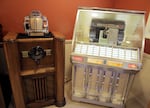
Al Menashe's audio collection. “This is my favorite,” said the retired Portland financier about the 1958 silver juke box. “Because I’ve got really good stuff in there: Dion and the Belmonts, Sam Cooke.”
Kristian Foden-Vencil / OPB
“When I was growing up, other kids would play baseball, and I would go to the Goodwill store and drag home phonographs,” Menashe, 75, said. “Nobody wanted them.”
Menashe would pay a nickel or a dime to fix them up, by replacing old springs or the delicate reproducer membranes, on which the needle vibrates to make sound.
His dining room is also lined with old music machines, like a player piano that incorporates a violin. There’s also a 1910 Victor Model Six, with rich red wood and gold filigree. He bought it from another collector back when there was no eBay. He had to search out like-minded individuals via phone and letter.
“I like to listen to music on the original equipment,” Menashe explained, putting an old recording of the Italian opera singer Enrico Caruso on the turntable. “I just love to listen to Caruso on this phonograph, because this was the phonograph people had back then.”
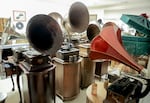
Just part of Al Menashe's phonograph collection, “When I was growing up, other kids would play baseball, and I would go to the Goodwill store and drag home phonographs,” Menashe said. "Nobody wanted them.”
Kristian Foden-Vencil / OPB
The sound is scratchy and tinny compared to the flawless digital recordings of today. But the format definitely adds something to the Caruso listening experience.
Menashe’s cylinder collection is priceless, and at the same time worth about $4 per cylinder. They were so common in the ‘30s that people used them for sharp shooting. But some recordings, like those of Thomas Edison’s voice or a song about the sinking of the Titanic, can sell for about $100.
While Menashe focused on cylinders, phonographs and 78 rpm records as a kid, his attention turned to rock and roll and the 45 rpm singles when he was in his teens.
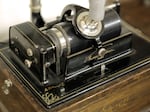
Menashe’s cylinder collection is priceless, and at the same time worth about $4 per cylinder. They were so common in the ‘30s that people used them for sharp shooting. But some recordings, like those of Thomas Edison’s voice or a song about the sinking of the Titanic, sell for about $100.
Kristian Foden-Vencil / OPB
Picking out one of his Wurlitzers, he presses “B-4” and on comes the deep tenor of Gene Chandler, singing “Duke of Earl.”
“Now that’s music,” Menashe smiles.
Menashe has boxes and boxes of 45s and 78s, not collected one-by-one at a store, but from all the collections contained by his Wurlitzers when he bought them.
“They all come from the Portland area,” Menashe explained, “from bars, clubs and restaurants. So whatever records were in them at the time, I bought with the machines.”
Related: Record Store Day goes from essential support to celebration of music
One might expect Menashe to line up with other record collectors on Record Store Day this Saturday. But no.
“I haven’t bought a record in 20 years,” Menashe said. “I don’t like the new stuff.”
Record Store Day is a big deal in Portland. Terry Currier with Music Millennium helped set up the first event in 2008, with record store owners from 17 other cities.
Currier said it’s a must-see for collectors.
“When we open at 8 o’clock, the last couple of years there’s been over 300 people in line,” Currier said.
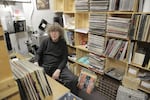
Terry Currier with Music Millennium helped set up the first event in 2008, with record store owners from 17 other cities. He said it’s a must-see for collectors.
Kristian Foden-Vencil / OPB
Taylor Swift, Gracie Abrams, the Grateful Dead and 350 other bands will release special vinyl and CD recordings to register their support for small, independent record stores on Saturday.
But Menashe is more interested in the audio machines themselves, rather than the records they contain. He hasn’t really even checked to see if any of his old records are worth much.
“That part of collecting I was never actually interested in,” Menashe said.
But he has estimated the value of his Wurlitzer and phonograph collection. It comes to about $300,000. But he thinks that figure is dropping as collectors who focus on phonographs and Wurlitzers grow old and pass away.
In fact, what’s going to happen to his collection when he passes is something that’s been on his mind, and the mind of his wife, Esther Menashe.
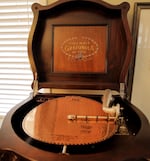
Al Menashe's audio collection has all kinds of different machines from the last 125 years.
Kristian Foden-Vencil / OPB
“It’s a problem,” he said. “I told Esther, ‘If something happens to me, call up one of the major auction houses in the country and have them shipped out and sold there.‘”
He’s thought about donating the collection, “A local museum may take one machine. But they’re not going to want 15 Wurlitzers!” Menashe said.
Meanwhile those riding the latest wave of vinyl appreciation might learn from Menashe about both the joys of collecting this Record Store Day — and the pitfalls.
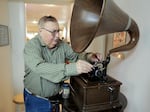
What’s going to happen to Al Menashe's collection when he passes is something that’s been on his mind, and the mind of his wife Esther Menashe.
Kristian Foden-Vencil / OPB


